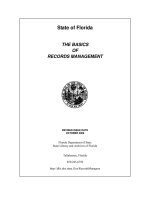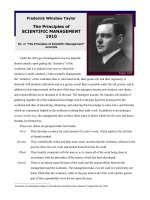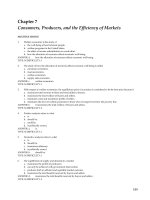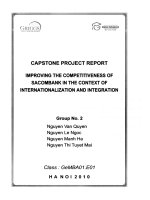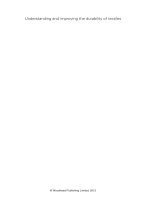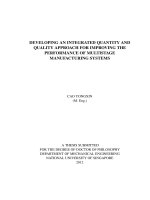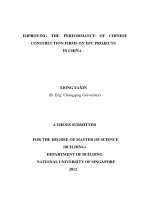Improving the efficiency of quality management system ISO 9001 2015 in habeco breweries
Bạn đang xem bản rút gọn của tài liệu. Xem và tải ngay bản đầy đủ của tài liệu tại đây (2.72 MB, 92 trang )
ĐẠI HỌC QUỐC GIA HÀ NỘI
KHOA QUẢN TRỊ VÀ KINH DOANH
---------------------
DƯƠNG THỊ VIỆT NGA
IMPROVING THE EFFICIENCY OF QUALITY MANAGEMENT
SYSTEM ISO 9001:2015 IN HABECO BREWERIES
NÂNG CAO HIỆU QUẢ CỦA HỆ THỐNG
QUẢN LÝ CHẤT LƯỢNG ISO 9001:2015
Ở CÁC CÔNG TY SẢN XUẤT BIA THUỘC HABECO
LUẬN VĂN THẠC SĨ QUẢN TRỊ KINH DOANH
HÀ NỘI - 2019
ĐẠI HỌC QUỐC GIA HÀ NỘI
KHOA QUẢN TRỊ VÀ KINH DOANH
---------------------
DƯƠNG THỊ VIỆT NGA
IMPROVING THE EFFICIENCY OF QUALITY MANAGEMENT
SYSTEM ISO 9001:2015 IN HABECO BREWERIES
NÂNG CAO HIỆU QUẢ CỦA HỆ THỐNG
QUẢN LÝ CHẤT LƯỢNG ISO 9001:2015
Ở CÁC CÔNG TY SẢN XUẤT BIA THUỘC HABECO
Chuyên ngành: Quản trị kinh doanh
Mã số: 60 34 01 02
LUẬN VĂN THẠC SĨ QUẢN TRỊ KINH DOANH
NGƯỜI HƯỚNG DẪN KHOA HỌC: TS. TRẦN HUY PHƯƠNG
HÀ NỘI - 2019
DECLARATION
The author confirms that the research outcome in the thesis is the result of
author’s independent work during study and research period and it is not yet published in
other’s research and article.
The other’s research result and documentation (extraction, table, figure, formula,
and other document) used in the thesis are cited properly and the permission (if required) is
given.
The author is responsible in front of the Thesis Assessment Committee, Hanoi
School of Business and Management, and the laws for above-mentioned declaration.
Date…………………………..
Author
Duong Thi Viet Nga
ACKNOWLEDGEMENT
First of all, I would like to thank HSB leaders, teachers, staffs who gave me many
useful helps throughout my graduate studies and graduation thesis. In particular, I would
like to express my special thanks to Dr. Tran Huy Phuong for his valuable guidance,
scholarly inputs and consistent encouragement throughout the implementation of my thesis
research.
I also sincerely thank all leaders, managers, employees in Hanoi Beer Alcohol
Beverage Joint Stock Corporation, Habeco member companies, especially my ISO
department colleagues for all kindly helps in providing information, creating conditions
and spending their precious time for me to complete my research work.
Furthermore, completion of my master thesis was possible with the constant support
of my ISO specialists, especially Mr. Mai Huu Tuyen, for their practical advices and
comments at any time I need helps. I would like to express my sincere gratitude to all of
them.
Finally, I would like to give my thanks and love to my parents, husband and children
for their love, support and sacrifices during my study and doing my master thesis.
With the help from many sides, I have made great efforts to complete the thesis on
time and in the best way. However, due to limitations in information and knowledge, my
thesis could not avoid some shortcomings. Therefore, I am very grateful to receive the
sympathy, contributions from my teachers and HSB science council to make my master
thesis become better.
CONTENT
ABBREVIATIONS............................................................................................................... i
LIST OF FIGURES ............................................................................................................. ii
LIST OF TABLES .............................................................................................................. iii
TITLE CHAPTER .............................................................................................................. 1
CHAPTER 1: THEORETICAL BACKGROUND ON IMPROVEMENT OF THE
EFFICIENCY OF QUALITY MANAGEMENT SYSTEM ISO 9001:2015 ................. 6
1.1. Concepts of ISO systems and ISO 9001:2015................................................................ 6
1.1.1. Overview of ISO systems ............................................................................................ 6
1.1.2. Principles of 9001:2015 ISO system ........................................................................... 8
1.1.3. Expected benefits of ISO 9001:2015 system ............................................................. 17
1.2. Efficiency of applying ISO 9001:2015 in enterprises .................................................. 18
1.2.1. Definition of efficiency ............................................................................................. 18
1.2.2. Criteria to measure the efficiency of ISO 9001:2015 system .................................... 18
1.2.3. Factors influencing the efficiency of ISO 9001: 2015 system .................................. 20
CHAPTER 2: THE REAL SITUATION OF ISO 9001:2015 SYSTEMS IN SOME
HABECO BREWERIES................................................................................................... 24
2.1. Introduction of Habeco Corporation ............................................................................ 24
2.1.1. History of Habeco Corporation ................................................................................. 24
2.1.2. Vision and mission of Habeco Corporation .............................................................. 25
2.1.3. Habeco product introduction ..................................................................................... 26
2.2. Evaluation of the ISO 9001:2015 efficiency in Habeco breweries .............................. 27
2.2.1. The context of Habeco head quarter and its breweries .............................................. 27
2.2.2. The real situation of applying ISO 9001: 2015 in some Habeco breweries .............. 29
2.2.3. Evaluation of factors affecting ISO 9001 performance ............................................. 41
CHAPTER 3: SOLUTIONS FOR IMPROVING THE EFFICIENCY OF ISO 9001
IN HABECO BREWERIES ............................................................................................. 50
3.1. Habeco’s future directions for development ................................................................ 50
3.2. Solutions for improving the efficiency of ISO 9001:2015 in Habeco group ............... 50
3.2.1. Organization of training courses for Habeco group .................................................. 51
3.2.2. Establishment of a common ISO 9001:2015 system for Habeco Corporation.......... 53
3.2.3. Establishment of a software to control Habeco ISO 9001:2015 system ................... 60
CONCLUSIONS ................................................................................................................ 66
REFERENCES .................................................................................................................. 67
APPENDICES.................................................................................................................... 72
APPENDIX 1 ..................................................................................................................... 72
APPENDIX 2 ..................................................................................................................... 73
APPENDIX 3 ..................................................................................................................... 77
APPENDIX 4 ..................................................................................................................... 78
APPENDIX 5 ..................................................................................................................... 79
APPENDIX 6 ..................................................................................................................... 81
ABBREVIATIONS
No
Abbreviations
Original meanings
1.
ISO
International Organization for Standardization
2.
Habeco
Hanoi Beer Alcohol Beverage Joint Stock Corporation
3.
JSC
Joint Stock Company
4.
LTD
Limited Company
5.
HHT
Hanoi – Hoanghoatham Brewery
6.
ML
Hanoi – Melinh Brewery
7.
HQ
8.
KB
Hanoi - Kimbai Beer Joint Stock Company
9.
TB
Hanoi - Thaibinh Beer Joint Stock Company
10.
HHP
Habeco Haiphong Beer Joint Stock Company
11.
ID
12.
NA
Hanoi - Nghean Beer Joint Stock Company
13.
QB
Hanoi - Quangbinh Beer Joint Stock Company
14.
QT
Hanoi - Quangtri Beer Joint Stock Company
15.
ND
Hanoi - Namdinh Beer Joint Stock Company
16.
TH
Thanhhoa Beer Joint Stock Company
17.
HP
Hanoi - Haiphong Beer Joint Stock Company
18.
HH
Hanoi - Hongha Beer Joint Stock Company
19.
HD
Hanoi - Haiduong Beer Joint Stock Company
20.
T89
Trading 89 Beer Joint Stock Company
21.
DEPT.
Department
22.
MAN.
Management
23.
QMR
Quality Management Representative
Habeco Headquarter + Hanoi – Hoanghoatham Brewery +
Hanoi – Melinh Brewery
Hanoi Beer - Alcohol - Beverage Investment and
Development Joint Stock Company
i
LIST OF FIGURES
Figure 1.1: Representation of the structure of ISO 9001:2015 in the PDCA cycle ............ 14
Figure 1.2: QMS 9001:2015 levels of documentation ........................................................ 15
Figure 2.1: Labor productivity in Habeco groups ............................................................... 31
Figure 2.2: Number of customer complaints on canned and bottled beers ......................... 32
Figure 2.3: Comparison of returned product ratios in Habeco companies .......................... 33
Figure 2.4: Assessment of satisfaction in ISO 9001 application ......................................... 34
Figure 2.5: ISO system structures in Habeco group ............................................................ 35
Figure 2.6: The use of outdated documents in Habeco members ........................................ 36
Figure 2.7: Time for giving out solutions for non-conformities and prevention actions .... 38
Figure 2.8: Documented non-conformities in Habeco group .............................................. 39
Figure 2.9: Types of documented non-conformities in Habeco Head quarter .................... 40
Figure 2.10: The general evaluation of ISO 9001 efficiency in Habeco group................... 41
Figure 2.11: Driving force to get ISO 9001 ........................................................................ 42
Figure 2.12: Top management commitment evaluation in Habeco group .......................... 43
Figure 2.13: Evaluation of documents relating on customer focus ..................................... 44
Figure 2.14: Evaluation of context understanding in member companies .......................... 44
Figure 2.15: Continuous improvements in Habeco group ................................................... 46
Figure 2.16: Internal auditor composition in Habeco group ............................................... 48
Figure 3.1: Five-layer ISO structure .................................................................................... 54
Figure 3.2: User decentralization in Habeco group ............................................................. 61
Figure 3.3: Management of changes in ISO documents ...................................................... 63
Figure 3.4: Suggested new procedure to make non- conformity and prevention report ..... 65
ii
LIST OF TABLES
Table 1.1: PDCA application in ISO 9001 .......................................................................... 12
Table 1.2: Risk matrix based on ISO 31010 (ISO 31010, 2009)......................................... 14
Table 1.3: The differences between ISO 9001:2015 to ISO 9001:2008 ............................. 16
Table 2.1: ISO standards in Habeco member companies .................................................... 28
Table 2.2: Time needed for giving out solutions for preventive actions ............................. 37
Table 2.3: Time needed for giving out solutions for non-conformities............................... 38
Table 2.4: Consultants of ISO 9001 in Habeco group ......................................................... 46
Table 3.1: Steps for improving the efficiency of ISO 9001:2015 in Habeco groups .......... 51
Table 3.2: Abbreviations of documents and method of usages ........................................... 54
Table 3.3: Amendments of head quarter ISO documents .................................................... 55
Table 3.4: Abbreviations of compilation breweries/companies/departments in Habeco
group .................................................................................................................................... 57
Table 3.5: Document issuance in Habeco head quarter....................................................... 58
Table 3.6: Document issuance in Hanoi – Melinh and Hoanghoatham Breweries ............. 58
Table 3.7: Document issuance in member companies ........................................................ 59
Table 3.8: Internal auditor groups ....................................................................................... 60
Table 3.9: Functions of departments in head quarter, breweries and companies ................ 62
iii
TITLE CHAPTER
Name of the thesis in Vietnamese: ―Nâng cao hiệu quả của hệ thống quản lý chất lượng
ISO 9001:2015 ở các công ty sản xuất bia thuộc HABECO‖
Name of the thesis in English: ―Improving the Efficiency of Quality Management System
ISO 9001:2015 in Habeco Breweries‖
1. Rationale
Hanoi Beer Alcohol Beverage Joint Stock Corporation (Habeco) is the third largest
beer company in Vietnam. Being fully aware of the important role of ISO 9001 in
production and business, the head quarter has developed and applied the quality
management system ISO 9001 since January 2002. This can be considered as an "entry
visa" for the company's products to penetrate, affirm its position in the market. However,
Habeco currently has approximately 13 member companies, producing a variety of
products like Bia Hoi Ha Noi (draught beer), bottle and can beers. Each company has built
its own ISO 9001 system suitable for its company. Of all 13 companies, 10 companies
have being applied ISO 9001 both version 9001:2008 and 9001:2015; 2 companies applied
ISO 9001 but did not get certificate, 1 company obtained ISO 9001 certification in 2012
but did not go through surveillance and recertification audits.
It is stated that getting an ISO certificate is not a difficult task, but maintaining and
promoting the effect, its efficiency are very difficult. It is more and more difficult to
integrate 13 ISO 9001 systems into head quarter to better the quality management of the
same products. It requires a lot of effort from all members of not only Habeco head quarter
but also every member companies. Belows are some drawbacks of the ISO 9001 systems
of member companies:
Diversified ISO system structures due to differences in hiring consultant and
certification companies: The 4 level system (Handbook – Procedures – Operational
Documents – Records) is currently used in Habeco head quarter and some member
companies. However, some others have built systems with the integrated level 2
and 3 documents. The unsimilarity in ISO systems make it difficult for the ISO
department in Habeco head quarter to control and integrate all separated systems.
Different ways of ISO 9001 contruction causes the use of outdated documents:
Some companies in Habeco group considered Habeco issued documents as external
documents that they have to follow. Some have converted these documents into
their internal documents by rewriting and adding some small changes. This leads to
1
chances of using out of date information because of untimely modification when
the head quarter make amendment or renewal of documents.
Different organization context, leaders and leadership commitment and unequal
level of ISO staffs and internal auditors: Based on its own context, the company
should determine, monitor and regularly review external and internal issues that are
relevant to its purposes and its strategic directions, affecting its ability to achieve
the intended results of its quality management systems. The leaders of the company
and the ISO training programs play an important role in leadership commitment and
the qualifications of internal auditors, respectively. It is the fact that higher
leadership commitment and higher qualifications of auditors lead to higher
efficiency of the ISO system. Most of the member companies are lack of education
on the role of applying ISO systems in management. Therefore, some leaders, ISO
staffs and internal auditors attach less importance to it, they even consider ISO as
the adornments of their companies.
Difficulty and waste of time to solve unconformable raw materials and products:
When finding unsatisfied goods from nominated suppliers or having nonconformities in processing, member companies should report to the head quarter.
However, due to lack of specific procedures, this process can take long time so that
some companies handled by themselves, even skipped. It might result in the risks of
miscontrol of the product quality and loss of Habeco market share.
For purposes of contributing to the maintenance and enhancement of the efficiency
of the ISO 9001:2015, I chose the topic: "Improving the Efficiency of Quality Management
System ISO 9001:2015 in Habeco Breweries”.
2. Literature review
Promas (2010) studied the factors that influence the effective implementation of ISO
9001 in small and medium service companies. The purpose of this study is to investigate
the critical factors for the effective implementation of the ISO 9001 standard in small and
medium enterprises (SMEs) operating in the services sector. The author used primary data
obtained by a questionnaire survey attentive to the managers who are responsible for
quality in each of the 93 ISO 9001:2000-certified service companies in Greece. Individual
critical factors for ISO 9001:2000 implementation are assessed for importance by simple
descriptive statistics (Sampaio et al., 2009). Furthermore, exploratory factor analysis is
then applied to refine these individual critical factors into five latent constructs (Fotopoulos
2
et al., 2009). All of the individual critical factors examined in the study are assessed with
regard to their contribution to ISO 9001 efficiency. The five latent constructs of the
underlying structure of these critical factors are (in descending order of importance):
―internal motivation of company‖; ―attributes of company‖; ―employee attributes‖;
―requirements of the quality system‖; and ―attributes of the external environment‖. These
findings were similarity with the study of Williams (2004) and Magd (2006) who studied
the manufacturing companies. This study provides practical guidance for SME service
companies that wish to implement the ISO 9001:2008 standard effectively by focusing its
effort on these 5 latent factors that impact efficiency. Despite its important findings, the
limitation of the study lies in its small sample size of SMEs. Future research could utilize
a broader sample of private SME service companies.
Zeng (2007) tried to explore barriers in the implementation of ISO 9001 in China,
and identify how to overcome these barriers. By using a structural questionnaire survey,
the author highlighted the problems in implementing the standard, which determines the
sustainable implementation, including: short-sighted goal for ―getting certified‖; overexpectation on the ISO 9001 standard; mandatory requirement (not wholehearted
commitment) in some industries; and following others (the trend) in certification. With
regard to the effective audit of the ISO 9001 standard which plays an important for
sustainable implementation of the ISO 9001 standard (Rajendran and Devadasan, 2005),
the main problems were explored, including: lack of commitment from some certifying
bodies; excessive competition between certifying bodies; and offering of a total packaged
service from consultancy to certification by certifying bodies.
Mc Adam (2002) assessed the body of knowledge relating to ISO 9000 and Total
Quality Management (TQM) interrelationships, with specific reference to the UK and Irish
brewing sector. The author decided to use sectoral study method (Remenyl et al., 1998)
for further investigation of the ISO-TQM continuum.
Based on data obtained by a
questionnaire survey of the 90 leading UK and Irish brewing companies, the research
indicated that ISO may be used as a foundation on which to develop TQM. ISO has mixed
success as a continuous improvement approach, with its bureaucratic nature being
considered restrictive. Furthermore, ISO was found as having a limited impact on customer
satisfaction, while this was one of the key benefits of TQM. The implementation of
customer satisfaction measures was found to be a major differentiating factor for ISO and
TQM; relatively few ISO-only companies had adopted such measures. However, the study
3
is limited by the small size of the UK and Irist brewing companies. Future research could
utilize a broader sample of other breweries all over the world, especially breweries in large
corporation.
Although these topics have pointed barriers to the poor performance and indicated
ways to improve the efficiency of the ISO 9001 system, researches were done in small and
medium-sized service businesses, in breweries in the UK and Irish. They were also limited
to one or some individual businesses. However, there is no study on the ISO system for a
beer corporation like Habeco. Therefore, the author found the topic "Improving the
Efficiency of Quality Management System ISO 9001:2015 in Habeco Breweries” is a new
one and is not duplicated with other research topics which have been done before.
3. Aims of research
The purpose of this study is finding the best ways to improve the efficiency of
quality management system ISO 9001:2015 for Habeco breweries. This will contribute to
the maintenance and enhancement of the efficiency of the ISO 9001:2015, resulting in the
increase of Hanoi beer quality for the customers.
4. Objects of research
The object of the study is the efficiency of quality management system ISO
9001:2015 in Habeco breweries.
5. Scope of research
In order to fully cover types of Habeco member companies and types of beer
production, the study chose all 13 member companies which have applied ISO 9001.
The research was done based on the data collected in the recent 3 years from 2015 2017.
6. Research methodology
In this research, the author used research tools as well as data collection methods as
follows:
The primary data: It was decided to use quantitative and qualitative study. The indepth well-planned interviews were made with persons who play a key role in
implementing and making ISO system efficient. They are senior and medium
managers, ISO representatives, head/deputy head of departments, staffs and
workers in all Habeco breweries. Expert interviews aimed at gathering and
reaffirming important information and identifying trends in the implementation, as
well as giving solutions for increase the efficiency of ISO 9001 systems. Besides,
4
internal audits were also made in all breweries in order to get the overall picture of
ISO 9001 implementation in all member companies.
The secondary data: Periodical and annual reports on non-conformities of raw
materials, by-products and products,
data on labor productivity and
product
quality were taken from ISO Department, Human Resource Department and
Quality Management Department of Habeco head quarter and member companies.
7. Thesis structure
In addition to the title chapter, conclusion, references, appendices; The content of the
thesis is divided into three main chapters:
Chapter 1: Literature reviews on improvement of the efficiency of ISO 9001 system
Chapter 2: The real situation of ISO 9001:2015 systems in some Habeco breweries
Chapter 3: Future directions for improving the efficiency of ISO 9001 in Habeco
breweries.
5
CHAPTER 1: THEORETICAL BACKGROUND ON IMPROVEMENT OF THE
EFFICIENCY OF QUALITY MANAGEMENT SYSTEM ISO 9001:2015
1.1. Concepts of ISO systems and ISO 9001:2015
1.1.1. Overview of ISO systems
The International Organization for Standardization (ISO) is an international standardsetting body founded on 23 February 1947 to promote the development of international
manufacturing, trade, and communication standards. The ISO story began in 1946 when
delegates from 25 countries met at the Institute of Civil Engineers in London and decided
to create a new international organization ―to facilitate the international coordination and
unification of industrial standards‖. Because the 'International Organization for
Standardization' would have different acronyms in different languages (IOS in English,
OIN in French for Organisation Internationale de Normalisation), its founders decided to
give it the short form ISO which is derived from the Greek ―ISOS‖ meaning ―equal‖.
The work of preparing International Standards is normally carried out through more
than 250 ISO technical committees. ISO members can choose whether they want to be part
of a particular technical committee, and their (Cascio, 1996). Normally, the development
of an international standard is a multi-stage process: Proposal – Preparatory – Committee –
Enquiry – Approval – Publication.
Until now, ISO has published over 22,208 International Standards covering almost
all aspects of technology and manufacturing (ISO, 2018). Therefore, it takes time to find
and understand which ones are the most suitable for our business. While some are
industry-specific, many of the most popular standards are generic and can be implemented
into an organization no matter what sector it is in. Below are some most popular standards.
1.1.1.1.ISO 9000
It is the most popular standard that can be applied in any organization in any sector.
There are fourteen members in a family of quality management standards. It was first
published in 1987, last in 2015, and has been updated about every 7 years. Nowadays, ISO
9001:2015 is the only one that can be certified to (ISO 9000). Over 1,100,000 ISO
certifications have been given out in over 170 countries (Charlet, 2017).
The standard details how to put a Quality Management System (QMS) in place to
better prepare your organization to produce quality products and services. It is customer
focused, and places an emphasis on continuous improvement, risk management and top
management processes that extended throughout the organization.
6
The ISO 9000 is now made up of three main standards. It is highly recommended to
use ISO 9000 to become familiar with the fundamental concepts, principles and normative
vocabulary of a quality management system before adopting ISO 9001 to achieve an
effective level of performance. The practices described in ISO 9004 may then be
implemented to make your quality management system more efficient in achieving your
business goals and objectives.
1.1.1.2. ISO 14000
It is a family of standards relating to the environment, similar to ISO 9000. ISO
14001:2015 is the most popular in the family, and is the only one in which an organization
can be certified (ISO 14000). It establishes requirements for an Environmental
Management System (EMS) and is based on the continuous improvement model PDCA
(Plan-Do-Check-Act).
Although it is a voluntary standard, put in place by companies who want to
improve their processes, it is now very popular, with nearly 350,000 certifications in 171
countries worldwide (Charlet, 2017).
1.1.1.3. ISO 22000
It is focused on the development and implementation of a food safety management
system, and is a requirement for any organization that works in the food chain. With
multiple standards including 22001 for food and drink, 22002 for food manufacturing, and
more, this family is used in a variety of organizations directly or indirectly involved with
food such as restaurants, food manufacturers, food transportation services (ISO 22000).
It can be applied on its own or integrated with ISO 9001. Over 32,000 ISO 22000
certifications has been given out all over the world (Charlet, 2017).
1.1.1.4. ISO 50001
One of the newest standards which is Released in 2011, the energy standard ISO
50001:2011 is nevertheless becoming increasingly important (ISO 50001). It is meant for
companies to put in place an Energy Management System (EnMS) dedicated to improving
energy usage and efficiency. This includes reducing an organization’s energy footprint by
reducing greenhouse gas emissions as well as energy cost.
Although it is not required, but with over 20,000 certifications and a 69%
certification increase in 2016 compared to 2015, it is clear that companies are finding
benefits and think the standard improves their business processes (Charlet, 2017).
7
1.1.1.5. ISO 45001
It was developed by a committee of occupational health and safety experts. It will
take into account other International Standards in this area such as OHSAS 18001, the
International Labour Organization's ILO-OSH Guidelines, various national standards and
the ILO's international labour standards and conventions.
ISO 45001, Occupational
health
and
safety
management
systems
-
Requirements, that will help organizations reduce this burden by providing a framework to
improve employee safety, reduce workplace risks and create better, safer working
conditions (ISO 45001).
1.1.2. Principles of 9001:2015 ISO system
1.1.2.1. Seven principles of 9001:2015 ISO system
ISO 9001 standard sets out the principles for a quality management system which is
a way of defining how an organization can meet the requirements of its customers and
other stakeholders affected by its work. It does not specify what the objectives relating to
―quality‖ or ―meeting customer needs‖ should be, but requires organizations to define
these objectives themselves and continually improve their processes in order to reach them.
Customer focus: It is the top most items in 7 quality management principles that
creates a core base for businesses. It highlights the potential benefits to an
organization of implementing a quality management system (QMS), including: the
ability to consistently provide products and services that meet customer and
applicable statutory and regulatory requirements and facilitating opportunities to
enhance customer satisfaction. Below are some points that an organization should
do to meet the customer focus in ISO 9001:2015 standard:
Understand the needs of existing and future customers
Align organizational objectives with customer needs and expectations
Meet customer requirements
Measure customer satisfactions
Manage customer relationships
Aim to exceed customer expectations
Leadership: The leadership importance of top management has always been in any
ISO systems. A system is bound to run into problems without ongoing management
support. There are many ways that top management needs to demonstrate his
leadership and commitment with respect to the QMS, such as being accountable for
8
the Efficiency of the QMS, ensuring resources are available, promoting continual
improvement, and ensuring the Quality Policy and objectives are in place and
consistent with the goals of the organization and the QMS.
Engagement of people: This is a new requirement in ISO 9001:2015 version for
top management to ―engage‖ everyone who contributes to the efficiency of the
quality management system. ―Engagement‖ is defined as ―the involvement in, and
contribution to activities to achieve shared objectives.‖ (ISO 9000, 2015).
Therefore, the rationale for this principle is that the creation of unity of purpose,
direction, and engagement enable an organization to align its strategies, policies,
processes, and resources to achieve its objectives. In order to do this, top
management is required to:
Ensure that people’s abilities are used and valued
Make people accountable
Enable participation in continual improvement
Evaluate individual performance
Enable learning and knowledge sharing
Enable open discussion of problems, constraints
Process approach: This process approach is one of the most important items in a
quality management system. ―A process is a set of interrelated or interacting
activities that use inputs to deliver an intended result‖ (ISO 9000, 2015). The
process approach enhances an organization’s efficiency in achieving its defined
objectives. In relation to ISO 9001:2015, it means enhancing customer satisfaction
by meeting customer requirements.
Improvement: Rationale improvement is essential for an organization to maintain
current levels of performance, to react to changes in its internal and external
conditions and to create new opportunities. Some actions that a successful
organization always do to have an ongoing focus on improvement:
Establish improvement objectives at all levels of the organization.
Ensure and empower that people at each levels are competent to apply tools
and methodologies to achieve improvement projects.
Integrate improvement considerations into the development of new or
modified goods, services and processes.
Recognize and acknowledge improvements.
9
Evidence-based decision making: Decision making can be a complex process, and
it always involves some uncertainty. However, decisions based on the analysis and
evaluation of facts, data and information; the understanding of cause-and-effect
relationships are likely to produce more precise results with greater objectivity and
confidence. In order to do that, some actions that an organization has to take such
as:
Determine, measure and monitor key indicators to demonstrate the
organization’s performance.
Ensure that data and information are sufficiently accurate, reliable, secure
and available to the relevant people.
Ensure people are competent to analyze and evaluate data and information
using suitable methods
Make decisions and take actions based on evidence, balanced with
experience and intuition.
Relationship management: For sustained success, an organization manages its
relationships with all of interested parties such as suppliers, partners, customers,
investors, employees, and society as a whole. In order to optimize their impacts on
its performance, an organization should:
Determine and prioritize interested party relationships
Establish relationships that balance short and long-term considerations.
Pool and share information, expertise and resources with relevant interested
parties.
Measure performance and provide performance feedback to interested
parties
Establish collaborative development and improvement activities
Encourage and recognize improvements and achievements by interested
parties.
1.1.2.2. ISO 9001:2015 process approach
Besides above 7 principles, new version ISO 9001:2015 is also a perfect employment
of the process approach, which incorporates the Plan-Do-Check-Act (PDCA) cycle and
risk-based thinking.
PDCA cycle: It enables an organization to ensure that its processes are adequately
resourced and managed, and that opportunities for improvement are determined and
10
acted on. In accordance with the requirements of ISO 9001:2015, the following
table provides examples of how an organization could do to manage its quality
management system (ISO 9000, 2015).
11
Table 1.1: PDCA application in ISO 9001
Steps in process
Guidance
approach
PLAN
Gather, analyze and determine external and internal responsibilities.
Define the context
Monitor or communicate frequently with these interested parties to
ensure continual understanding of their requirements, needs and
expectations.
Define the scope,
objectives and
policies
Determine the
processes
Determine the
process sequence
Determine the scope, boundaries and applicability based on the
internal and external context and interested party requirements.
Decide the addressed markets
Establish objectives and policies
The
processes
include
management,
resources,
operations,
measurement, analysis and improvement.
Define and describe the process network and their interactions by
using tools such as modeling, diagrams, matrices and flowcharts.
Organize and define ownership, accountability, individual roles,
Define process
owners
responsibilities, working groups, remits, authority
Ensure the competence for the effective definition, implementation,
maintenance and improvement of each process and its interactions.
Define processes
need to be
documented
Define the
interfaces, risks
and activities
within the process
Define the
monitoring and
Use risk‐ based thinking
Use documented methods: graphical representations, user stories,
written instructions, checklists, flow charts, visual media or
electronic methods including graphics and systemization.
Determine the activities, measures and inherent controls required to
transform the inputs into the desired ouputs.
Determine the risks to deliver unintended products and services to
customers
Determine where and how monitoring and measuring should be
applied.
measurement
Identify the validation necessary to assure Efficiency and efficiency
requirements
of the processes and system.
DO
12
Steps in process
Guidance
approach
Implement
Define the
resources needed
Perform activities, monitoring, measures and controls of defined
processes and procedures, outsourcing, etc
Human
resources
(knowledge),
infrastructure,
environment,
information, natural resources, materials, financial resources.
CHECK
Verify the process
against its planned
objectives
Measurement, monitoring, reviews, audits and performance
analysis.
ACT
Corrective action include identification and elimination of the root
Improvement
causes of the problems
Use small-step continual improvement (―Kaizen‖), breakthrough
improvements (innovation).
Risk-based thinking: Risk, ―effect of uncertainty‖ (ISO 9000, 2015) enables an
organization to determine the factors that could cause its processes and its quality
management system to deviate from the planned results, to put in place preventive
controls to minimize negative effects and to make maximum use of opportunities as
they arise. The concept of risk-based thinking has been implicit in previous editions
of this International Standard ISO 9001 for achieving an effective quality
management system. It includes carrying out preventive action to eliminate
potential nonconformities, analyzing any nonconformities that do occur, and taking
action to prevent recurrence that is appropriate for the effects of the nonconformity
(ISO 31000, 2018).
13
Figure 1.1: Representation of the structure of ISO 9001:2015 in the PDCA cycle
Table 1.2: Risk matrix based on ISO 31010 (ISO 31010, 2009)
Probability
Consequences
Insignificant
Minor
Moderate
Major
Severe
Almost certain
Medium
High
High
Very High
Very High
Likely
Medium
Medium
High
High
Very High
Possible
Low
Medium
Medium
High
Very High
Unlikely
Low
Medium
Medium
Medium
High
Rare
Low
Low
Medium
Medium
High
1.1.2.3. ISO 9001:2015 document structure
The QMS 9001:2015 international standard specifies levels of documentation that an
organization must observe to document its quality management system. This structure
(Figure 1.2) could be applied for all ISO standards such as ISO 9001, ISO 14001, and ISO
22000.
14
1. Quality Manual
2. Procedures
3. Work processes/
instructions
4. Records
Figure 1.2: QMS 9001:2015 levels of documentation
Level 1: Quality Manual: prescribes the minimum requirements for the content of a
quality manual. The standard recognizes that the structure and format of the manual
will depend on the size, culture and complexity of the organization.
Level 2: Quality Procedures: are required for the following six tasks: control of
documents, records, internal audits, nonconforming products, corrective and preventive
actions.
Level 3: Work Processes / Instruction: describes how to undertake a specific part of a
function, or activity. It is similar to a procedure but is characterized by increased focus
and further detail on a particular task. Work instruction is mandatory, and must be
subordinate to a procedure.
Level 4: Records are a way of documenting that the policies, procedures, and work
instructions have been followed. Records may be forms that are filled out, a stamp of
approval on a product, or a signature and date on some type of document, such as
routing sheet. Records are used to provide traceability of actions taken on a specific
product or batch of products. They provide data for corrective actions and a way of
recalling products, if necessary.
1.1.2.4. Comparison between ISO 9001:2015 and ISO 9001: 2008
In 2015, a new version of the standard, ISO 9001:2015, has just been launched for
replacing the previous version ISO 9001:2008 (ISO 9001, 2008). In fact, all ISO standards
15
are reviewed and revised regularly to make sure they remain relevant to the marketplace
and take into account the different challenges that businesses in the globalization now face
such as more complex supply chains, increased customer expectations, etc. The
comparison of ISO 9001:2015 to ISO 9001:2008 was done in Table 1.3 (IQCS
Certification, 2016).
Table 1.3: The differences between ISO 9001:2015 to ISO 9001:2008
No
1
Items
ISO 9001:2008
Structure
Eight clauses
ISO 9001:2015
-
Ten
clauses:
1.
Scope;
2.
Nominative references; 3. Terms and
definitions;
organization;
4.
Context
5.
of
Leadership;
the
6.
Planning; 7. Support; 8. Operation;
9.
Performance
evaluation;
10.
Improvement.
- Reorganization of clause order and
content to better align with other
standards (High level structure).
2
Context of the No requirement
An organization must determine,
organization
monitor and review internal and
external issues as well as relevant
interested party requirements.
3
Documented
Six
required Document
information
procedures
the
QMS
scope,
objectives, quality policy and any
process the organization determines
needs to be documented
4
Risk
based Preventive actions
thinking
5
Exclusions
Organizations must take actions to
address risks and opportunities
& Excluding a standard Any requirement that cannot be
requirements
requirement that was applied may be excluded as long as it
specific
to
product is justified.
realization
6
Objects, outputs, Process based only
The process model is expanded to
products
include anything that affects quality.
and
16

